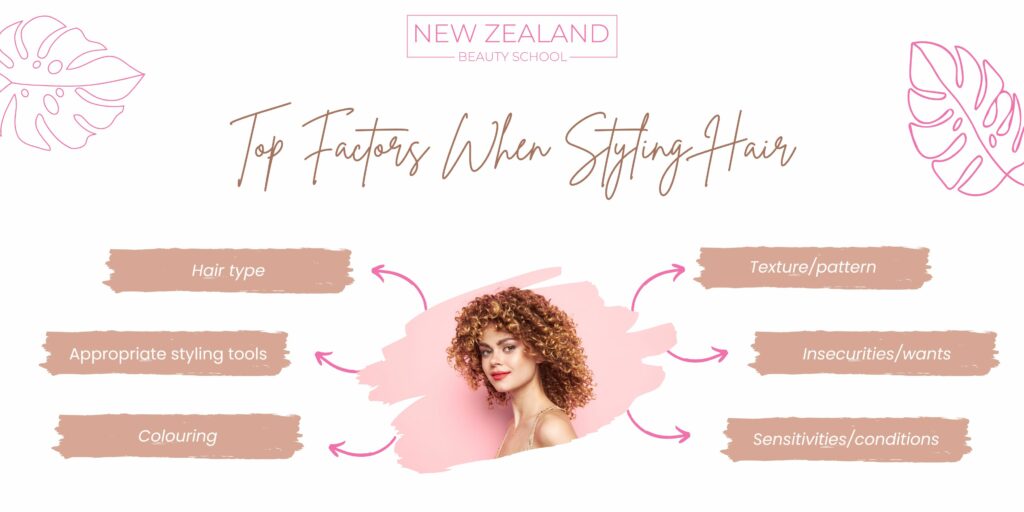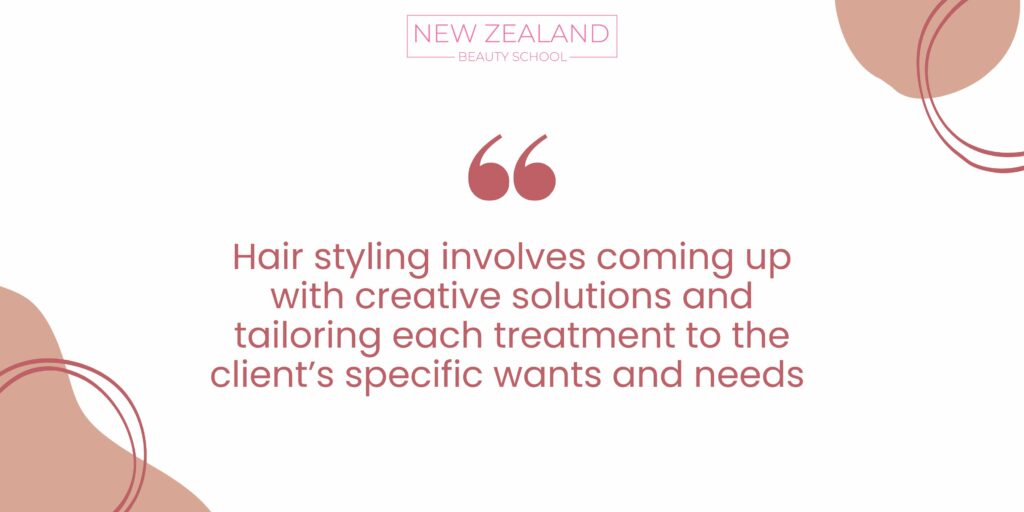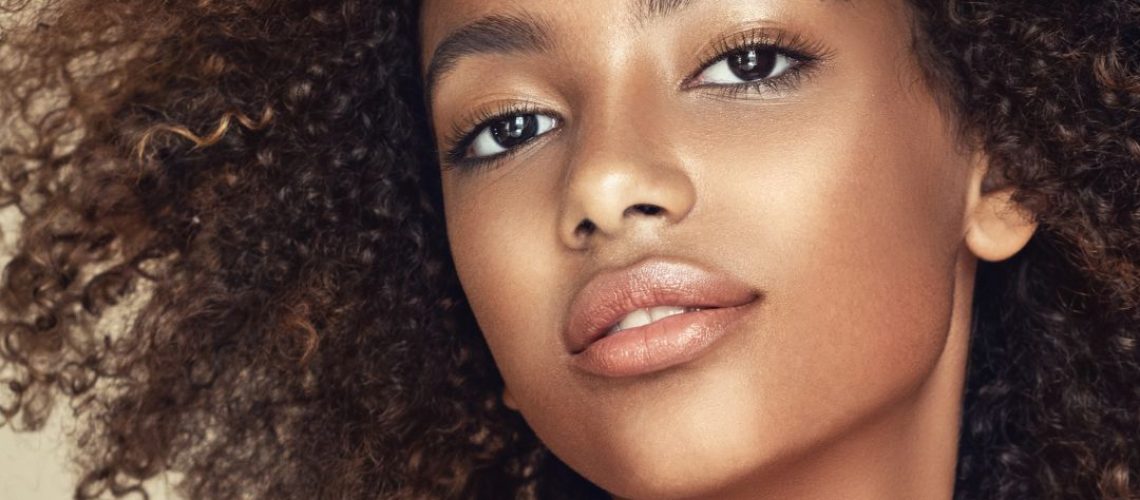Always had a fascination for that crazy stuff that grows out of the top of our heads? Want to help people feel their very best? Then perhaps a career as a hairstylist could be your calling!
But before you begin, there are a few basics you’ll need to know. We have compiled a list of some of the foundations of hair styling to give you a solid start on your hairstylist journey.
Getting to know hair and its unique needs
Hair is entirely unique to every person, in colour, thickness, style, texture…the list goes on! This means that every client will have very specific needs for their hair, and it is the job of the stylist to have the knowledge and skill to best advise on and deliver top-quality service.
Here are some of the biggest, most basic factors to be considered when styling hair:
Hair type
Everyone’s hair will have a different structure and porosity. Structure refers to hair thickness – whether you have thick, medium or fine hair.
Thicker hair, whilst often sought after, can be easily tangled and difficult to manage due to there being so many layers of hair to reach, whilst fine hair can prove difficult to style and volume. Medium thickness hair can go either way, so getting to know how a client’s specific hair reacts to certain products, weather, and how it looks daily is a vital first step when choosing styles.
Porosity is a measure of how well your hair absorbs products and moisture. More porous hair is often due to a tear or gap around the hair cuticle, so while the hair absorbs moisture quickly, it can struggle to retain it, resulting in brittle hair or dryness. On the other end, the flat-laying cuticles of low porosity hair can cause product build-up, becoming visible again to the scalp and hairline.
Hair texture / pattern
Straight, wavy, curly. Within each of these categories also lies varying levels of pattern; for example: waves and curls can be defined on a chart from 2A (light waves) to 4C (tight coily hair). Each hair texture has different needs and poses different challenges, so being knowledgeable about all hair textures and patterns is of the utmost importance.
Talking through the specifics
What issues does your client face with their hair daily? What are their main insecurities and wants for their hair? It is vital to recognise that while hair overall can be placed into categories, every single head of hair will vary slightly, so flexibility, creative problem-solving and the ability to create tailored treatments for each individual are important skills for a hairstylist to possess.
Scalp sensitivities / Pre-existing conditions
Knowing whether your client suffers from any pre-existing hair or scalp conditions can greatly affect the treatments and styling you recommend. With conditions such as sensitive skin and allergies, psoriasis, eczema, hair loss or thinning etc., it is necessary to make sure your client feels safe and comfortable to talk about any worries they may have so that you can offer them the best possible service and make them feel their best.
Colouring
If the hair has been subject to regular colouring, this adds an extra layer of care to be considered. Colourants can dry or damage if the hair has not been properly nourished and cared for or perhaps has been coloured for a long time.
Extensive tool and product knowledge
Get to know your gadgets! Making sure you have solid foundational knowledge in all styling tools and how to use them safely and to the best of their ability will stand you in very good stead, ensuring confidence in yourself and the client. Also, a repertoire of product know-how will make sure you always have a plan up your sleeve for any hair emergency.
Sage words of wisdom never go amiss, particularly from those who know what they’re talking about! Our American neighbours at Allure offer an extensive list of some of the best tips and tricks from professional hair stylists.

Stylist and client communication
We’ve all been there – sat in the salon chair feeling too nervous about expressing what we want, inevitably ending up with a cut you don’t necessarily love and having to wait for it to grow out before trying again.
Well, we say no more!
One of the biggest elements of being a hairstylist is creating an open and friendly line of communication between yourself and the client. Your clients should feel comfortable telling you what they want as you go along – a bit more off here, keep the front how it is etc. – and as the stylist, it is important that you let your client know what is happening at each stage of the cut or style.
Hair styling involves coming up with creative solutions and tailoring each treatment to the client’s specific wants and needs. You want them to leave feeling like a million bucks, and making them feel heard and listened to is one of the best ways to ensure this outcome. The Minnesota School of Cosmetology offers a brilliant blog on the vitality of communication in a salon and how to go about achieving it.

Becoming a hairstylist with New Zealand Beauty School
Liking what you hear? Want to get started? One of the best ways to get going is by taking a hair styling course. There are courses suitable for every level, from a hair styling short course or hairdressing short courses to hair styling courses for beginners – there is sure to be something to suit you!
At New Zealand Beauty School, we offer a course on hair extensions, opening up a whole host of possibilities for creative hairstyling without having to wait for a client’s locks to reach Rapunzel-length proportions!
The benefits of studying a hair styling course online are endless – our 24/7 online learning system allows you the flexibility to work your studies around your schedule and get to grips with your craft from the comfort of your home. We’ll even send you your custom-made kit with everything you need to get started – pretty neat, huh?
This comprehensive hair styling course based in New Zealand will teach you the fundamental theoretical and practical skills that you will need in order to deliver high-quality, personalised services as a hair extension technician. You will master the different hair extension installation methods and be equipped with essential hair extension aftercare and maintenance knowledge.
Our course includes lessons on:
- tape wefts
- custom tape design
- nanobeads
- microbeads
- flat-track wefts
- beaded wefts
- invisible wefts
- how to appropriately use and install fusion, braided wefts and temporary methods such as clip-ins, wigs and fringe pieces.
Hair extensions remain an extremely high-demand salon service for hairstylists, so why not take advantage of this demand and get your career off to a flying start with our Certificate in Hair Extensions?
